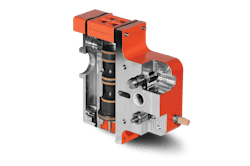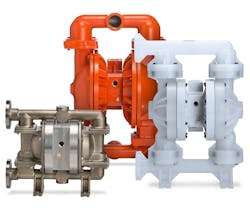How AODD Pumps with Effective Air Distribution Systems can Reduce Energy Costs
Every aspect of human life is impacted by energy. Its importance is so profound that society would cease to function as effectively and optimally as it does today without energy. The world has several resources that contribute to the energy pie, such as natural gas, refined crude oil and coal, among many others.
But energy isn't without its costs, which is why industrial manufacturing operations need to look at their framework to ensure they are functioning as efficiently as possible. Energy costs continue to climb, but the price is not the only consideration.
Many industrial companies are developing new manufacturing and production methods to help reduce their energy costs and environmental footprint. Sustainable manufacturing is the term used to describe these new methods. While those methods are admirable and effective, they also come with higher upfront implementation costs.
This leaves many operations with a dilemma. Do they opt for sustainable manufacturing to improve the environment in the long term but suffer financially in the short term? Do they forgo sustainability efforts altogether but adversely impact the environment and still pay premium prices on rising energy costs?
According to KPMG’s 2020 Survey of Sustainability Reporting, about 80% of the world’s leading companies incorporate sustainability programs into their day-to-day operations. For those on both sides of the sustainability spectrum, the challenge will be finding ways to achieve and continuously improve those sustainability measures. The technology used in these operations plays a pivotal role.
The Challenge with Current AODD Pump Technology
Depending on the utilized technology, some industrial companies can maintain their outputs while reducing their energy consumption. One example comes from operators that use air-operated double-diaphragm (AODD) pumps. This technology uses air as a power source, but electricity makes that supply – sourced by an air compressor – possible. Even though air serves as the primary power source, it still needs electricity to function.
Still, how it uses electricity can be the difference between excess energy consumption and sustainable manufacturing. The importance of energy efficiency and its impact on the bottom line can be found when looking closer at the price of electricity in recent years.
READ MORE: Compressed air - the hidden utility
On a national level, the average price for a kilowatt/hour (kWh) 6 years ago was 7 cents. In the spring of 2021, that price point nearly doubled to 13.3 cents per kWh. In 2022, it rose another cent to an average of 14.5 cents per kWh. Even three states – North Dakota, Montana and Oregon – that saw a drop in their electricity prices between 2021 and 2022 still saw their averages jump 3-4 cents higher from the 2017 mark.
Other states, however, experienced price hikes above 20 cents per kWh in 2022. Those states included Alaska, California, Connecticut, Hawaii, Maine, Massachusetts, New Hampshire and Rhode Island.
Out of context, those price jumps might seem miniscule considering it’s a matter of a few pennies in some states. But even a few pennies worth of price increases can add up fast to a company’s bottom line. Add in the fact that industrial manufacturing serves as an essential driver of the global economy, and it’s apparent how fast those costs add up.
For example, industrial pumping systems are involved in 20% of the world’s electricity demand, according to the Hydraulic Institute. Another key fact is one that many pump operators are aware of – 90% of the costs associated with owning a pump comes from its energy consumption. Those additional cents per kWh truly have a large impact on the cost of doing business.
Potential Savings Through Sustainable Manufacturing
While pumps require their share of energy to function, reducing those amounts by 30% to as high as 50% by using equipment or upgrading the pump's control system is possible. Because those energy savings are possible, pumps should be a prime target for operators looking to reduce their carbon footprint and trim their operating costs simultaneously.
That’s why sustainable manufacturing is paramount for operators now and well into the future. According to the World Commission on Environment and Development, sustainable manufacturing meets today’s energy needs without adversely affecting future generations. This effort, in practice, involves operators finding ways to be more economical in their manufacturing processes and using components and equipment to keep waste to a minimum and have less impact on the environment.
There are several factors that industrial operations must consider when it comes to sustainable manufacturing. Those factors include manufacturing cost, power consumption, operational safety and environmental friendliness. While many variables go into making an operation sustainable, having pumps that operate optimally and efficiently play a prominent role in achieving sustainable manufacturing.
WATCH MORE: Are Sustainability Engineering Roles in Demand?
Reduced Compressed Air Use Offers Possible Solution
Manufacturing facilities rely on pumps for several applications and tasks, such as loading and unloading raw materials and finished products to transferring fluids and waste products. The pump varieties are vast, but our focus is on one that relies heavily on electricity to function and serves as a main selection for utilitarian pumping applications.
As stated earlier, AODD pumps use air to operate but require an electrically powered driver, mainly a compressor or electric motor. This reciprocating, positive-displacement technology works well with industrial liquid-handling applications due to a simple, two-diaphragm design, which uses a common shaft and two inlet and two outlet ball valves. The compressed air drives the diaphragms, which prevents mechanical stress during operation, helping to maintain the pump's longevity.
This technology, though, requires an abundance of compressed air to operate, and that supply comes from another power source fueled by electricity. As we know, electricity prices have increased in recent years, meaning these pumps will be more expensive to operate without any other equipment or technology upgrades.
Fortunately, AODD pumps have technology that can reduce air consumption, which scales back on their electricity use. Air distribution systems serve as an enhancement to AODD pumps that optimize air flow within the equipment. Wilden, an AODD pump manufacturer, invented the Pro-Flo SHIFT Air Distribution System (ADS) to reduce the amount of compressed air required to operate an AODD pump.
While air distribution systems assist with air flow optimization, not all technologies boast the same benefits. Traditional air distribution systems have an inefficiency when working with AODD pumps. A time delay occurs when pressurized air switches from one chamber to the other in the AODD pump. This delay creates an overfill situation in the air chamber, forcing operators to vent it out of the pump, which does not provide any benefit to the pumping process.
The Wilden ADS overcomes this inefficiency by restricting air flow into the air chamber at the end of each pump stroke. This allows an efficient amount of air into the pump that keeps the process active. A specialized air control spool regulates the air to prevent overfilling without reducing product yield, providing reduced air consumption while maintaining the pump’s desired efficiency and flow rates.
Through the Pro-Flo SHIFT ADS, AODD pumps can operate with up to 60% less compressed air compared with other AODD pump technologies. Even with 60% less air, the AODD pumps can reach higher flow rates (up to 34%) than pumps without the Wilden ADS.
In fact, the Pro-Flo SHIFT ADS can operate reliably and efficiently with up to 60% less compressed air when compared to other AODD pump technologies while still being able to achieve flow rates that are up to 34% higher than competitive AODD pump models. Those performance enhancements can lead to much less energy consumption, saving the operators money and minimizing the environmental impact.
These types of efficiencies helped one manufacturing facility save up to $1,000 a year in energy costs by replacing their existing AODD pump with a Wilden model equipped with the Pro-Flo SHIFT ADS. The pump ran nearly 8 hours a day for 5 days a week.
Conclusion
Industrial companies do not have control of energy price fluctuations, but they can find ways to cut back on their consumption and environmental footprint. AODD pumps with compatible and effective air distribution systems can lessen energy consumption while also optimizing the pump's performance.
These small changes that industrial companies can make pay dividends for their operation and the environment.
This article was written and contributed by Tom Zuckett, AODD Business Development Manager, Americas for PSG and Wilden.
About the Author
Tom Zuckett
AODD Business Development Manager, Americas for PSG and Wilden
Tom Zuckett is the AODD Business Development Manager, Americas for PSG and Wilden and can be reached at [email protected].
Wilden is a brand of PSG, Oakbrook Terrace, IL, USA, a Dover company. PSG is comprised of several leading pump companies, including Abaque, All-Flo, Almatec, Blackmer, Ebsray, em-tec, Griswold, Hydro, Malema, Mouvex, Neptune, PSG Biotech, Quantex, Quattroflow, RedScrew, and Wilden. You can find more information on Wilden at psgdover.com/wilden and on PSG at psgdover.com.


